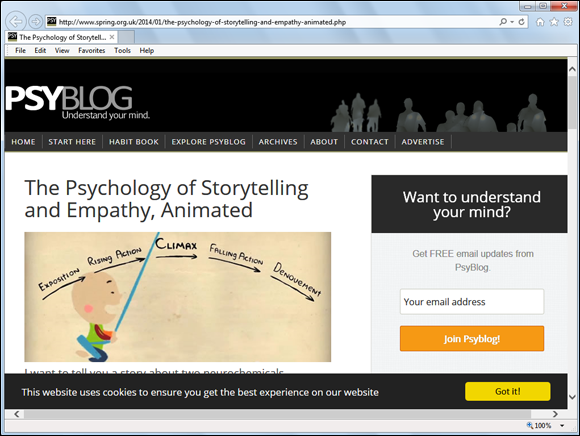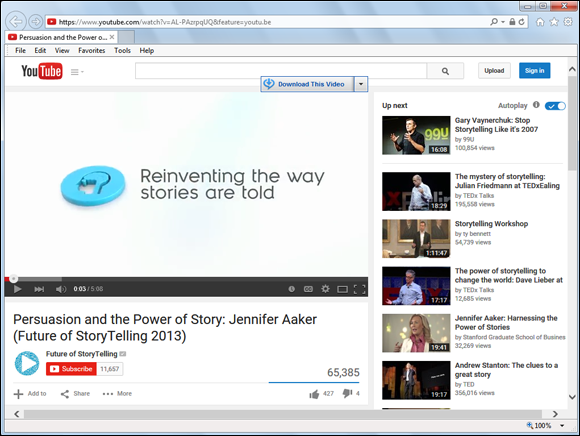Chapter 4
Creating Content That Tells a Story
IN THIS CHAPTER
 Understanding the science of storytelling
Understanding the science of storytelling
 Constructing product stories
Constructing product stories
 Writing great headlines
Writing great headlines
Most great content marketers know that storytelling is their secret weapon. They know that stories engage us; they have for centuries. Stories can be motivating and give us heroes to emulate. They can teach us how to act and how to cope. They also perform a critical function for the content marketer — persuasion.
In this chapter, you consider the value of storytelling, how to develop a compelling product story, and how to write headlines that capture attention.
Storytelling to Engage Your Audience
Now that the web helps everyone share stories, you need to create brand stories that others can tell for you. A great story can capture your customer’s attention as no other feature or benefits package can.
Seeking the science behind stories
People are hard-wired to love stories, but why is this so? A brief look at neuroscience holds the answer. More has been learned about the brain in the last ten years than the one hundred years before that. Scientist can analyze what happens to the chemicals in people’s brains as they respond to different stimuli.
The brain has three main “parts:” (1) the neocortex, where thinking, imagination, and problem-solving happen; (2) the limbic brain, where people retain memories, experience emotions, and form value judgments (consciously and unconsciously), among other things; and (3) the reptilian or “lizard” brain, which controls automatic physical functions and signals a “fight or flight" response in an attempt to keep them safe. The lizard brain relates to how the stories you tell influences your customers.
Consider this: The lizard brain responds when your customer perceives a threat. Even though the threat is not a stampeding animal herd, as it may have been in your ancestors’ day, customers may still perceive a kind of danger. In this case, it could be a high price or an assault on their time. They need to decide whether to stay or retreat. As a content marketer, your job is to mitigate that fear long enough to get your customer interested in your brand. So how do stories do that?
In his article in the Harvard Business Review, “Why Your Brain Loves Good Storytelling” (https://hbr.org/2014/10/why-your-brain-loves-good-storytelling/; see Figure 4-1), neuroscientist Paul J. Zak talks about the effect of the brain chemical oxytocin. He calls it the “it’s safe to approach others” brain signal that engenders empathy and cooperation. In the lab, Zak found that character-driven stories produce this effect.

FIGURE 4-1: Harvard Business Review.
Another study by Zak is reported in Jeremy Dean’s PsyBlog, shown in Figure 4-2. The blog quotes Zak as saying that “results show why puppies and babies are in toilet paper commercials. This research suggests that advertisers use images that cause our brains to release oxytocin to build trust in a product or brand, and hence increase sales” (http://www.spring.org.uk/2014/01/the-psychology-of-storytelling-and-empathy-animated.php).

FIGURE 4-2: PsyBlog.
The lizard brain is quieted by stories that help build trust. Such stories actually cause a chemical reaction. Every content marketer knows that trust is the key to building a lasting customer relationship. The screenwriter and teacher Robert McKee says that for business communication, you need to “unite an idea with an emotion.” So when you see long, boring articles about a product, you know they’re missing the mark.
So what are some keys to help you recognize good business stories? They include the following characteristics. They should:
- Be simple and straightforward. Have you ever stopped reading a novel because the action was hopelessly confusing? You probably decided that you didn’t want to waste your time trying to follow the plot. People have even less patience for a business story — they need a simple plot. That doesn’t mean that the story can’t be complex, but if you confuse your prospect, you’ve lost him.
- Evoke emotions. Attention is affected by brain chemistry. If you don’t provide some suspense, mystery, or conflict, you have no story.
- Use visuals. Web stories should have visuals to support them. An abundance of free, online sources of visual materials are available. Many social media studies show that content with visuals are understood and shared at a much higher rate than content without visuals. Imagery powerfully affects limbic brains. Also, although some people are much more visually inclined than others, not just in words but by imagery as well, so you need to show and tell.
-
Connect directly to the customer. Customers seek advice when they learn about your products. They want to know whether your products are a good fit for them. Telling stories about how great the company is doesn’t create the emotional connection. The connection comes when you tell customers how great they can be using your product.
 The point is really very simple. Customers are moved to spend money on your product when they believe that it will make them feel better, look better, or be better in the eyes of those around them. Think about that fact when you write your content.
The point is really very simple. Customers are moved to spend money on your product when they believe that it will make them feel better, look better, or be better in the eyes of those around them. Think about that fact when you write your content. - Have a beginning, middle, and end. As with any good story, you need to have the three story components. Leave something out and you’ve got some details, but not a cohesive story.
- Be authentic. Okay, you’ve probably heard this time and time again, but authenticity is critical to business storytelling. Telling a phony story is anathema to everything you know about engaging customers and building relationships. You can’t win. In addition, millennials are particularly captivated by stories about company values and giving. If you lie, you are lost.
Finding your product stories
This section begins with a basic rule. The product stories you tell should have the customer as the hero of the story. You can make your product the hero, but then you lose the interest of the customer. The customer’s focus is on himself, not you.
Your company has many stories to tell. Key among them are the messages that are derived from your mission and goals. (See Book 1, Chapter 1 for help with defining those goals.) These messages tell your customers how you will serve them. This section focuses on the stories you post every day on blogs, in articles, and on guest sites — the ones that keep your audience loyal and engaged. These stories are the bread and butter of content marketers.
So where can you find material for these company stories? You can get them from
- Loyal customers: Make sure that you and your team regularly interact with your best customers. They will always give you feedback about what you’re doing right. The stories about how they’re succeeding with your product are crucial to capture. They can also let you know what you can do better.
- Customer support staff: These people are on the front lines with your customers. They solve problems and know where the fault lines are. Make sure that they know you want to hear their stories.
- Other employees around the company: Don’t assume that only support people have stories to share. People throughout the company gain knowledge about customers that will help you create your messages.
- Vendors and colleagues: Your company is being talked about by customers and everyone who does business with you. Capture the good stories and try to fix the bad ones.
In short, stories are lurking everywhere. You just need to listen for them. These stories are the raw material that you use to make your content come to life. Another way to find stories is to look at what your data says. You can gather lots of great insights from your analytics that can be told as a story. When you marry data with a story, it’s easier to remember.
Jennifer Aaker of the Future of Storytelling organization (http://www.futureofstorytelling.org) talks about this concept in her YouTube video, “Persuasion and the Power of Story: (Future of StoryTelling 2013)” (https://youtu.be/AL-PAzrpqUQ; see Figure 4-3). Aaker says that because customers are overloaded with information, stories cut through the noise and help them to decide “what to believe in.”

FIGURE 4-3: Jennifer Aaker.
According to Aaker, three major characteristics of stories are what can make them so powerful. Stories can be (1) memorable, (2) impactful, and (3) personal. You can convince people by using statistics. But statistics alone don’t have an emotional impact. If you conjoin statistics with a story, the listener connects with the storyteller as well as the story, and persuasion becomes possible.

FIGURE 4-4: Roojoom.
Structuring Your Content Using Stories
So, how can you develop your own stories? If you’ve tried in the past but were less than successful, you likely didn’t use a tried-and-true storytelling structure. There’s no need to reinvent the wheel. Storytelling has been codified since Aristotle’s time (the fourth century).
Crafting the story
A great many story templates are available to you, and they can help you construct your brand story. They are all a variation on the hero’s journey, articulated by Joseph Campbell in his book The Hero with a Thousand Faces.
In brief, the framework involves a hero who will be taking a journey and will come out the other side a changed person. Here are the components and how they relate to a product story:
- Start with a look at the current reality. You start the story by telling the audience about the marketplace or give them some information to set the stage.
-
The hero has a problem. You introduce the hero, which in this case would be one of your customer personas. You want your prospects to make the connection to the hero as themselves and relate to his struggle. You talk about the problems and the feelings the hero is experiencing. These are the problems and feelings your customer has. For example, the hero could be short on time, overwhelmed by work, or be focused on some other problem.
 You’re telling this story to evoke emotions as well as recognition of the problem.
You’re telling this story to evoke emotions as well as recognition of the problem. - A mentor is introduced. The hero meets a guide who understands his fears and can help him with his struggle. The guide is your product or brand that has the answer to his problem.
- At first, the hero doesn’t want to accept the journey. This element adds drama to the story and reflects your customer’s indecision.
- Eventually, he takes action. The hero accepts the challenge to solve his problem using the guide’s advice, or he fails to take his advice and proceeds on his own. This is your call to action and the struggle itself.
- He succeeds or fails. As a result of his actions, the hero succeeds or fails. This result is determined by his execution of the guide’s advice. He can fail miserably if he doesn’t take his advice, or succeed if he does.
You can tell an unlimited amount of brand stories using this framework. As you work with it, you will recognize how common it is.
Incorporating copywriting
Okay, it’s time for some more definitions. Book 3, Chapter 1 discusses the difference between content marketing strategy and content strategy. Copywriting and content marketing have the same kind of difference. They are not one and the same; instead, they complement each other. Here’s a comparison of the two:
- Content marketing: You’re marketing your content to achieve business goals. The content you write is determined by what you want to accomplish from a macro perspective.
- Copywriting: You look at copywriting from a micro perspective. When you focus on copywriting, you consider the words and other devices, such as visuals, that you choose to compel your reader to do something specific. You’re enticing her to give you her email address, buy your product, or sign up for your newsletter. To this end, you use copywriting tactics such as great headlines or metaphors (and stories) to persuade her.
Because the use of great headlines is one of the most important copywriting techniques for content writers to employ — and do it well — here are some detail on headlines.
When you create headlines, you want to:
- Evoke emotion. As you’ve seen, emotions trigger attention and persuasion. If your headline is bland, the reader will pass it by on the way to something juicier.
- Attract the right reader. Your headline should make it clear who the article is targeted at — CEOs, small business owners, or others.
- Assist with search engine optimization (SEO). All this means is that if you use a keyword in your headline, you will help your customers find you.
- Make a meaningful promise. Readers always want to know what they will get from reading your article. Make that clear.
- Do the work of the entire article. As you know, some readers never get past the headline, so create a headline that has impact.
When you’re crafting your headlines, you don’t need to reinvent the wheel. Several good, free tools are available to assist you:
- CoSchedule’s Headline Analyzer (
http://coschedule.com/headline-analyzer): This tool gives you an overall score and breaks down your headline into several measures to help you improve it. - Headlinr (
http://headlinr.com/): This tool is unique because it provides you with proven headlines that match your keyword or topic. You can invoke it right from your browser, so it’s always there. - Hemingway App (
http://www.hemingwayapp.com): You can use this tool to test both your headline or your entire post. It makes suggestions about improving your content to make it clear. - The Readability Test Tool (
http://read-able.com/): This tool helps you determine whether your writing is appropriate for the targeted audience. It will help you simplify and make your content more readable.